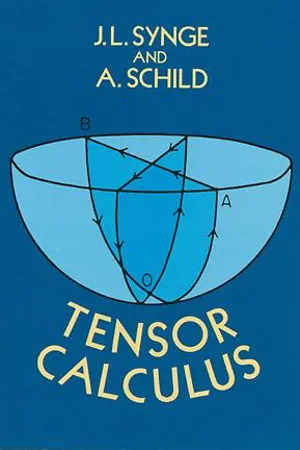
This is a test
- 336 pages
- English
- ePUB (mobile friendly)
- Available on iOS & Android
eBook - ePub
Tensor Calculus
Book details
Book preview
Table of contents
Citations
About This Book
`This book is an excellent classroom text, since it is clearly written, contains numerous problems and exercises, and at the end of each chapter has a summary of the significant results of the chapter.` — Quarterly of Applied Mathematics. Fundamental introduction for beginning student of absolute differential calculus and for those interested in applications of tensor calculus to mathematical physics and engineering. Topics include spaces and tensors; basic operations in Riemannian space, curvature of space, special types of space, relative tensors, ideas of volume, and more.
Frequently asked questions
At the moment all of our mobile-responsive ePub books are available to download via the app. Most of our PDFs are also available to download and we're working on making the final remaining ones downloadable now. Learn more here.
Both plans give you full access to the library and all of Perlego’s features. The only differences are the price and subscription period: With the annual plan you’ll save around 30% compared to 12 months on the monthly plan.
We are an online textbook subscription service, where you can get access to an entire online library for less than the price of a single book per month. With over 1 million books across 1000+ topics, we’ve got you covered! Learn more here.
Look out for the read-aloud symbol on your next book to see if you can listen to it. The read-aloud tool reads text aloud for you, highlighting the text as it is being read. You can pause it, speed it up and slow it down. Learn more here.
Yes, you can access Tensor Calculus by J. L. Synge, A. Schild in PDF and/or ePUB format, as well as other popular books in Mathematics & Calculus. We have over one million books available in our catalogue for you to explore.
Information
CHAPTER I
SPACES AND TENSORS
1.1. The generalized idea of a space. In dealing with two real variables (the pressure and volume of a gas, for example), it is a common practice to use a geometrical representation. The variables are represented by the Cartesian coordinates of a point in a plane. If we have to deal with three variables, a point in ordinary Euclidean space of three dimensions may be used. The advantages of such geometrical representation are too well known to require emphasis. The analytic aspect of the problem assists us with the geometry and vice versa.
When the number of variables exceeds three, the geometrical representation presents some difficulty, for we require a space of more than three dimensions. Although such a space need not be regarded as having an actual physical existence, it is an extremely valuable concept, because the language of geometry may be employed with reference to it. With due caution, we may even draw diagrams in this “space,” or rather we may imagine multidimensional diagrams projected on to a two-dimensional sheet of paper; after all, this is what we do in the case of a diagram of a three-dimensional figure.
Suppose we are dealing with N real variables x1, x2, ... , xN. For reasons which will appear later, it is best to write the numerical labels as superscripts rather than as subscripts. This may seem to be a dangerous notation on account of possible confusion with powers, but this danger does not turn out to be serious.
We call a set of values of x1, x2, .... xN a point. The variables x1, x2, ... , xN are called coordinates. The totality of points corresponding to all values of the coordinates within certain ranges constitute a space of N dimensions. Other words, such as hyperspace, manifold, or variety are also used to avoid confusion with the familiar meaning of the word “space.” The ranges of the coordinates may be from − ∞ to + ∞, or they may be restricted. A space of N dimensions is referred to by a symbol such as VN.
Excellent examples of generalized spaces are given by dynamical systems consisting of particles and rigid bodies. Suppose we have a bar which can slide on a plane. Its position (or configuration) may be fixed by assigning the Cartesian coordinates x, y of one end and the angle θ which the bar makes with a fixed direction. Here the space of configurations is of three dimensions and the ranges of the coordinates are
− ∞ < x < + ∞, − ∞ < y < + ∞, 0 ≤ θ < 2π.
Exercise. How many dimensions has the configuration-space of a rigid body free to move in ordinary space? Assign coordinates and give their ranges.
It will be most convenient in our general developments to discuss a space with an unspecified number of dimensions N, where N ≥ 2. It is a remarkable feature of the tensor calculus that no essential simplifi...
Table of contents
- DOVER BOOKS ON MATHEMATICS
- Title Page
- Copyright Page
- PREFACE
- Table of Contents
- CHAPTER I - SPACES AND TENSORS
- CHAPTER II - BASIC OPERATIONS IN RIEMANNIAN SPACE
- CHAPTER III - CURVATURE OF SPACE
- CHAPTER IV - SPECIAL TYPES OF SPACE
- CHAPTER V - APPLICATIONS TO CLASSICAL DYNAMICS
- CHAPTER VI - APPLICATIONS TO HYDRODYNAMICS, ELASTICITY, AND ELECTROMAGNETIC RADIATION
- CHAPTER VII - RELATIVE TENSORS, IDEAS OF VOLUME, GREEN-STOKES THEOREMS
- CHAPTER VIII - NON-RIEMANNIAN SPACES
- APPENDIX A - REDUCTION OF A QUADRATIC FORM
- APPENDIX B - MULTIPLE INTEGRATION
- BIBLIOGRAPHY
- INDEX